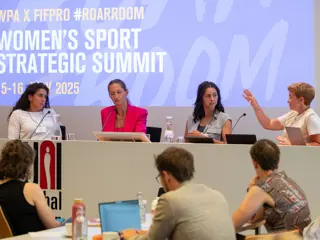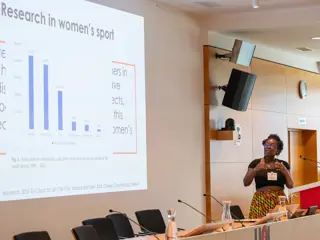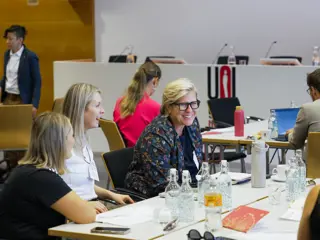News
Player health and commercial value in focus at Women's Sport Strategic Summit

The lack of dedicated research into women’s health and performance, as well as the commercial value of women's sport, was in focus at the Women’s Sport Strategic Summit 2025 in Nyon and Geneva, Switzerland.
Two separate events took place on 15-16 July as a backdrop to the 2025 UEFA Women’s EURO – the first hosted by World Players Association at the headquarters of UNI Global Union, and the second hosted by the International Labour Organization in collaboration with the Centre for Sport and Human Rights, the Swiss Government, and the Office of the United Nations High Commissioner for Human Rights (OHCHR).
A FIFPRO and player union delegation led panels and analysis that not only looked at the research gaps on health-related issues but how player associations are taking a proactive approach to bridge said gap, with Project ACL being highlighted as good practice.
"Player associations have an important role in bridging the gap between research and application of research," said Dr Alex Culvin, FIFPRO’s Director of Global Policy and Strategic Relations for Women's Football.
"We have a group of informed players who are keen to have more research – but only eight percent of all sports science research is carried out on women. Women’s football in particular has experienced exponential growth in recent times, yet research has not kept up at the same pace.
"Player associations therefore have a responsibility to undertake research informed by players in order to share evidence-based results that will make a positive difference for athletes in future."
🗣️ "This has been such a fantastic day. I've already learned so much, and I think it's important to learn from our brother and sister unions elsewhere around the world"
— FIFPRO (@FIFPRO) July 15, 2025
Day 1 from the Roar Room: Women’s Sport Strategic Summit ✅ #FIFPRO | @WorldPlayersUtd pic.twitter.com/tMTNYoPxp2
FIFPRO, the PFA, Nike, and Leeds Beckett University are collaborating on a three-year project to accelerate research into reducing Anterior Cruciate Ligament (ACL) injuries and increasing player availability in women’s football. The player-centric initiative is being piloted with footballers in England’s Women’s Super League.
Since being launched last year, Project ACL has helped stimulate significant progress:
- All 12 clubs in the WSL have completed the questionnaire and are participating in the second phase which includes interviews with multidisciplinary teams at all 12 clubs.
- An academic review of current research into ACL injuries and real-time tracking of player workload and travel has taken place.
- Ahead of the 2025/26 FA WSL season, a new research paper has been published to guide the next phase of the project.
Unlocking investment pathways for women’s sport
The Women’s Sport Strategic Summit also examined the commercial potential of women’s sport and how strategic collaboration between player associations and commercial partners can help unlock new investment pathways.
A National Women’s Soccer League (NWSL) case study illustrated the opportunities that exist to develop a more sustainable commercial future for women’s football and its athletes through commercialisation, while also showcasing the differences in challenges and possibilities between the US sports market versus those in other parts of the world.
"We talked about the means by which we determine our value and, specifically, our group licensing programme and how it's essential to building a strong union," said NWSLPA’s Executive Director Meghann Burke.
"Learning from different unions from different sports in different countries is critical; you pick up new ways of doing things, new ideas. Our union is stronger because of our relationships with other unions around the world."
The origins of the Women’s Sport Strategic Summit
World Players Association (WPA) in mid-2024 established a working group on women’s sport by bringing together player association leaders to drive tangible change for women athletes worldwide.
The group collaborates with WPA affiliates to share best practices and create a platform for collective action, addressing ongoing inequality and untapped potential in women’s sport.
"Sharing knowledge is a key part of our strategy; bringing player associations from around the world to learn from each other is what we believe in," said WPA’s Executive Director Walter Palmer.
"Player associations face so many challenges, so with the WPA bringing them together in one place, we’re able to extract those solutions and create a network of power."
The Women’s Sport Strategic Summit serves as the spearhead of the collaboration, where FIFPRO’s Women's Football Steering Council and player association leaders gather for a targeted session on sharing best practice and providing tangible, player-centric solutions.
As well as Dr Culvin, attendees from FIFPRO included Dr Frankie Brown (FIFPRO’s Head of Research & Strategy for Women's Football) and football player union representatives such as Camila Garcia (ANJUFF) and Meghann Burke (NWSLPA).



